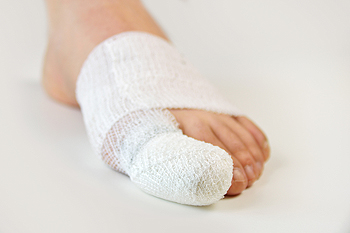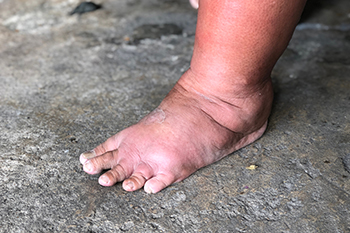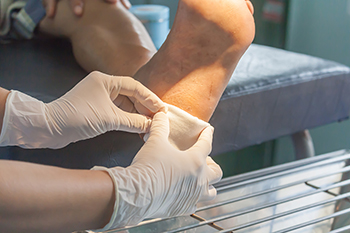Blog
Items filtered by date: July 2022
Four Categories of Broken Toes

The bones in the toes are known as phalanges, and the big toe consists of two phalanges. There are four types of broken toes that can occur, compressed, comminuted, displaced and non-displaced. In a comminuted fracture, the bone can break into several fragments. When force presses the ends of the bones towards the center, a compressed fracture has occurred. A bone that is moved out of its normal position is indicative of a displaced fracture, while a broken bone that stays in position is called a non-displaced fracture. The most common toe to break is the pinky toe, and this is often done by jamming it into a piece of furniture, or if something heavy drops on it. If the break is mild, buddy taping may be an effective way to promote stability to the toe as the healing process begins. This is done by taping the affected toe to the toe next to it, which may help keep it straight. If you suspect you have broken your toe, a podiatrist can provide an X-ray that can determine the extent of the fracture, and offer you correct treatment options.
A broken toe can be very painful and lead to complications if not properly fixed. If you have any concerns about your feet, contact Dr. Dean D. Hinners from Illinois. Our doctor will treat your foot and ankle needs.
What to Know About a Broken Toe
Although most people try to avoid foot trauma such as banging, stubbing, or dropping heavy objects on their feet, the unfortunate fact is that it is a common occurrence. Given the fact that toes are positioned in front of the feet, they typically sustain the brunt of such trauma. When trauma occurs to a toe, the result can be a painful break (fracture).
Symptoms of a Broken Toe
- Throbbing pain
- Swelling
- Bruising on the skin and toenail
- The inability to move the toe
- Toe appears crooked or disfigured
- Tingling or numbness in the toe
Generally, it is best to stay off of the injured toe with the affected foot elevated.
Severe toe fractures may be treated with a splint, cast, and in some cases, minor surgery. Due to its position and the pressure it endures with daily activity, future complications can occur if the big toe is not properly treated.
If you have any questions please feel free to contact one of our offices located in Metropolis and Eldorado, IL . We offer the newest diagnostic and treatment technologies for all your foot and ankle needs.
The Link Between Swollen Feet and Alcohol

Swelling can be a bothersome and annoying symptom for one to experience in their feet. Not only can it feel uncomfortable, but the swelling can also make it more difficult to walk and put weight on the feet. It is important for you to be aware of the different causes of swollen feet because, while this condition can be somewhat inconsequential in some cases, it can also point to serious underlying health complications in others. One of the often overlooked causes of swollen feet is related to the consumption of alcohol. When an individual drinks alcohol, especially in excessive quantities, this can cause them to retain water inside their bodies. This extra water retention can lead people to experience swelling in their feet. Swelling in the feet should subside within a couple of days. If it does not, then it could indicate a more serious problem with another part of the body, such as the kidney or liver. If you are beginning to experience swollen feet as a result of consuming alcohol, you might try elevating the feet to a height above the heart. This ultimately encourages and promotes blood circulation. To help counteract the swelling caused by alcohol, one might also try to reduce the amount of salt consumption. If you are experiencing swollen feet because of alcohol consumption, you can contact a podiatrist to receive help and learn more about how to treat this condition.
Swollen feet can be a sign of an underlying condition. If you have any concerns, contact Dr. Dean D. Hinners of Illinois. Our doctor can provide the care you need to keep you pain-free and on your feet.
Swollen feet are a common ailment among pregnant women and people who stand or sit for extended periods. Aging may increase the possibility of swollen feet and patients who are obese often notice when their feet are swelling too. There may be medical reasons why swollen feet occur:
- Phlebitis - A condition that causes the veins to become inflamed and can also cause leg pain.
- Liver disease - This may lead to low blood levels of albumin which is a protein. This can cause fluid in the blood to pass into the tissues and several areas of the body can become swollen.
- Heart failure - When the heart doesn’t pump properly the blood that is normally pumped back to the heart can pool in the veins of the legs causing swollen feet.
- Kidney disease - One of the main functions of the kidneys is releasing excess fluid in the body. This type of condition can make it difficult for the kidneys to function properly, and as a result the feet may become swollen.
- Deep-vein thrombosis (DVT)- This is a serious condition where blood clots form in the veins of the legs. They can block the return of blood from the legs to the heart which may cause the feet to swell. It is important to be treated by a podiatrist if this condition is present.
Swollen feet can also be caused by bone and tendon conditions, including fractures, arthritis, and tendinitis. Additionally, there may be skin and toenail conditions and an infection may cause the feet to swell. Patients who take medicine to treat high blood pressure may be prone to getting swollen feet.
Many patients elevate their feet to help relieve the swelling and this is generally a temporary remedy. When a podiatrist is consulted the reason behind the swelling can be uncovered and subsequently treated.
If you have any questions please feel free to contact one of our offices located in Metropolis and Eldorado, IL . We offer the newest diagnostic tools and technology to treat your foot and ankle needs.
Why Live with Pain and Numbness in Your Feet?
Types of Foot Ulcers

Patients who are diabetic may be familiar with wound care for the feet. Elevated blood sugar levels may cause a foot ulcer to gradually develop and immediate treatment may be necessary to avoid further implications, including amputation in severe cases. There are several types of foot ulcers that diabetic patients may experience. Neuropathy can cause a lack of feeling in the foot and patients are unable to feel the pain caused by an injury. A loss of blood flow to the feet can lead to an ischemic ulcer which can be difficult to treat. If the patient has poor circulation and neuropathy, a neuroischemic ulcer may form and it is said to be the most difficult to heal. Approximately half of foot ulcers become infected, therefore they need to be closely monitored. Diabetic foot ulcer treatment begins with removing infected tissue from the wound. This is called debridement and it is crucial in the prevention of damaged nerves, blood vessels, and tendons. This is followed by reducing existing pressure on the foot ulcer and draining the wound. If you have diabetes, it is strongly advised that you are under the care of a podiatrist who can treat and manage diabetic foot problems.
Wound care is an important part in dealing with diabetes. If you have diabetes and a foot wound or would like more information about wound care for diabetics, consult with Dr. Dean D. Hinners from Illinois. Our doctor will assess your condition and provide you with quality foot and ankle treatment.
What Is Wound Care?
Wound care is the practice of taking proper care of a wound. This can range from the smallest to the largest of wounds. While everyone can benefit from proper wound care, it is much more important for diabetics. Diabetics often suffer from poor blood circulation which causes wounds to heal much slower than they would in a non-diabetic.
What Is the Importance of Wound Care?
While it may not seem apparent with small ulcers on the foot, for diabetics, any size ulcer can become infected. Diabetics often also suffer from neuropathy, or nerve loss. This means they might not even feel when they have an ulcer on their foot. If the wound becomes severely infected, amputation may be necessary. Therefore, it is of the upmost importance to properly care for any and all foot wounds.
How to Care for Wounds
The best way to care for foot wounds is to prevent them. For diabetics, this means daily inspections of the feet for any signs of abnormalities or ulcers. It is also recommended to see a podiatrist several times a year for a foot inspection. If you do have an ulcer, run the wound under water to clear dirt from the wound; then apply antibiotic ointment to the wound and cover with a bandage. Bandages should be changed daily and keeping pressure off the wound is smart. It is advised to see a podiatrist, who can keep an eye on it.
If you have any questions, please feel free to contact one of our offices located in Metropolis and Eldorado, IL . We offer the newest diagnostic and treatment technologies for all your foot care needs.
Facts About Capsulitis of the Second Toe

The foot has 30 ligaments, five of which connect the long bones of the midfoot (metatarsals) to the toes (phalanges). The ligaments form a capsule around the joint, helping it to work properly when you walk, run, or jump. When such a ligament becomes inflamed, it causes a pain called capsulitis. The most common form of this condition occurs in the second toe, often the result of a bunion, a longer second toe, flat feet, or low arches. It is sometimes mistaken for Morton’s neuroma, but that is a separate condition that affects the nerves. Capsulitis of the second toe is progressive and worsens over time, usually because of genetics or overuse. Long-term wearing of high heels may also have contributed to this. A podiatrist can examine your foot to detect the source of the pain using an X-ray and manipulation of the affected area. Conservative treatments, such as ice, rest, medication, and orthotics may be recommended. Changing footwear, taping, and splinting can also help. If these methods are not effective, or if your condition is particularly advanced, surgery may be another option.
Toe pain can disrupt your daily activities. If you have any concerns, contact Dr. Dean D. Hinners of Illinois. Our doctor can provide the care you need to keep you pain-free and on your feet.
What Causes Toe Pain?
Most severe toe pain is caused due to a sports injury, trauma from dropping something heavy on the toe, or bumping into something rigid. Other problems can develop over time for various reasons.
Toe pain can be caused by one or more ailments. The most common include:
- Trauma
- Sports injury
- Wearing shoes that are too tight
- Arthritis
- Gout
- Corns and calluses
- Hammertoe
- Bunions
- Blisters
- Ingrown toenails
- Sprains
- Fractures (broken bones)
- Dislocations
When to See a Podiatrist
- Severe pain
- Persistent pain that lasts more than a week
- Signs of infection
- Continued swelling
- Pain that prevents walking
Diagnosis
In many cases the cause of toe pain is obvious, but in others, a podiatrist may want to use more advanced methods to determine the problem. These can range from simple visual inspections and sensation tests to X-rays and MRI scans. Prior medical history, family medical history, and any recent physical traumatic events will all be taken into consideration for a proper diagnosis.
Treatment
Treatments for toe pain and injuries vary and may include shoe inserts, padding, taping, medicines, injections, and in some cases, surgery. If you believe that you have broken a toe, please see a podiatrist as soon as possible.
If you have any questions please feel free to contact one of our offices located in Metropolis and Eldorado, IL . We offer the newest diagnostic tools and technology to treat your foot and ankle needs.

